Bosch 1900 User Manual
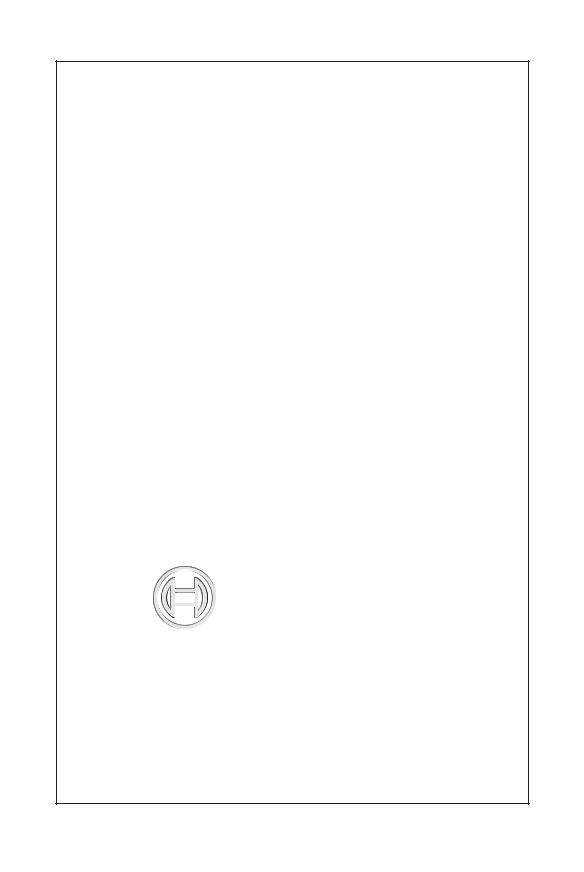
Do not use the appliance without reading the instruction manual.
Ne pas utiliser l’appareil sans avoir lu son mode d’emploi au préalable.
No utilice el electrodoméstico sin leer el manual de instrucciones.
Operating/Safety Instructions
Consignes de sécurité/d’utilisation
Instrucciones de funcionamiento y seguridad
UniversalAquatak 1900
Call Toll Free for |
Pour obtenir des informa- |
Llame gratis para |
Consumer Information |
tions et les adresses de nos |
obtener información para |
and Service Locations |
centres de service après- |
el consumidor y |
|
vente, appelez ce numéro |
ubicaciones de servicio |
|
gratuit |
|
|
||
1-844-900-AQUA (1-844-900-2782) |
||
|
|
|
For English Version |
Version française |
Versión en español |
See page 2 |
Voir page 19 |
Ver la página 36 |
F016L81610 1900.indd 1 |
|
|
5/3/17 9:06 AM |
|
|
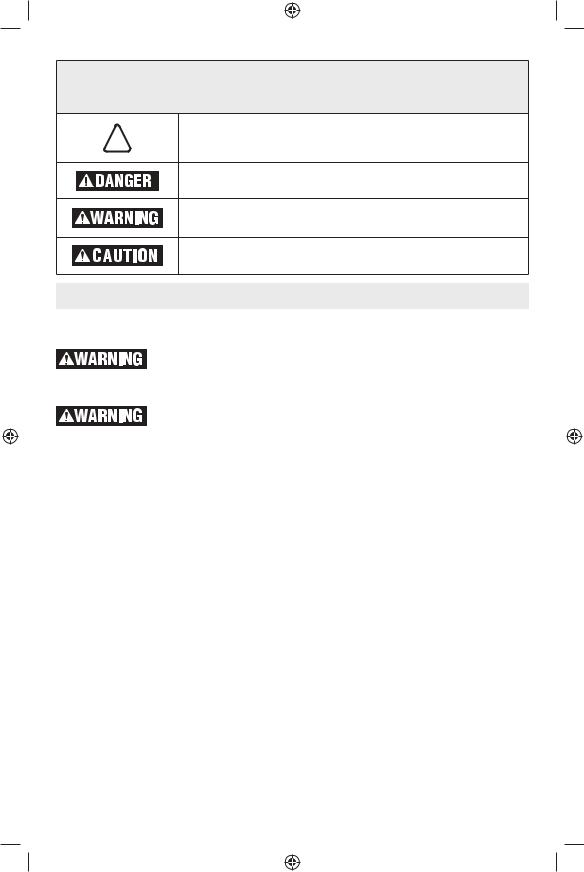
Safety Symbols
The definitions below describe the level of severity for each signal word. Please read the manual and pay attention to these symbols.
!personal injury hazards. Obey all safety messages that follow this symbol to avoid possible injury or death.
DANGER indicates a hazardous situation which, if not avoided, will result in death or serious injury.
WARNING indicates a hazardous situation which, if not avoided, could result in death or serious injury.
CAUTION, used with the safety alert symbol, indicates a hazardous situation which, if not avoided, will result in minor or moderate injury.This is the safety alert symbol. It is used to alert you to potential
General Safety Rules
IMPORTANT SAFETy INSTRUCTIONS
Read all safety warnings and all instructions. Failure to follow the warnings and instructions may result in electric shock, fire and/or serious injury.
SAVE ALL WARNINGS AND INSTRUCTIONS FOR FUTURE REFERENCE
When using this product, basic precautions should be followed, including the follow-
ing:
Work area
Do not operate pressure washers in explosive atmospheres, such as in the presence of flammable liquids, gases or dust. Pressure washer create sparks which may ignite the dust or fumes.
Keep children and bystanders away while operating a pressure washer. Distractions can cause you to lose control.
Store idle pressure washer out of reach of children and other untrained persons.
Tools are dangerous in the hands of untrained users.
Do not leave pressure washer running unattended, turn power off. Do not leave pressure washer until it comes to a complete stop.
Personal safety
Stay alert, watch what you are doing and use common sense when operating a pressure washer. Do not use a pressure washer while you are tired or under the influence of drugs, alcohol or medication. A moment of inattention while operating pressure washers may result in serious personal injury.
Always wear eye protection marked to comply with ANSI Z87.1 and use personal protective equipment. Protective equipment such as dust mask, non-skid safety shoes, hard hat, or hearing protection used for appropriate conditions will reduce personal injuries.
Prevent unintentional starting. Ensure the switch is in the OFF position before connecting to power source, picking up or carrying the pressure washer. Carrying pressure washers with your finger on the switch or energizing pressure washers that have the switch ON invites accidents.
Watch your balance and footing while using your power washer. Surfaces become slippery when wet and are extra slippery when using a detergent or cleaner.
Do not operate the equipment while barefoot or when wearing sandals or similar lightweight footwear. Wear protective footwear that will protect your feet and improve your footing on slippery surfaces.
Do not overreach. Keep proper footing and balance at all times. This enables better control of the pressure washer in unexpected situations.
Materials containing asbestos and other materials which contain substances which
2 |
SAVE THESE INSTRUCTIONS |
|
|
F016L81610 1900.indd 2 |
5/3/17 9:06 AM |
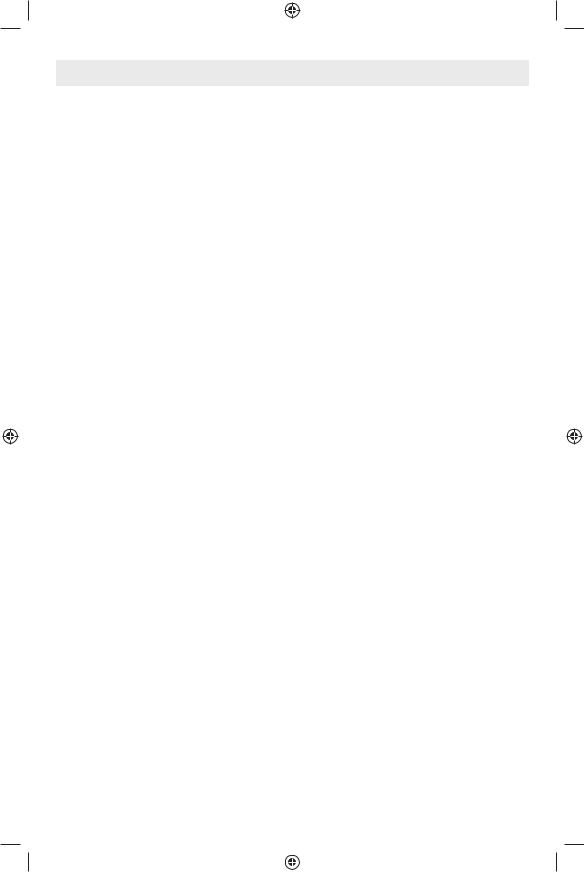
General Safety Rules
are hazardous to your health must not be sprayed. Your risk from these exposures varies, depending on how often you do this type of work. To reduce your exposure to these substances: work in a well ventilated area, and work with approved safety equipment, such as masks that are specifically designed to filter out microscopic particles.
“Stay alert”. Do not allow familiarity gained from frequent use of your pressure washer to become commonplace. Always remember that a careless fraction of a second is sufficient to inflict severe injury.
Use only accessories that are recommended by the manufacturer for your model. Accessories that may be suitable for one pressure washer, may become hazardous when used on another pressure washer.
Electrical safety
Pressure washer plugs must match the outlet. Never modify the plug in any way.
Unmodified plugs and matching outlets will reduce risk of electric shock.
Avoid body contact with earthed or grounded surfaces such as pipes, radiators, ranges and refrigerators. There is an increased risk of electric shock if your body is earthed or grounded.
Do not abuse the cord. Never use the cord for carrying, pulling or unplugging the pressure washer. Keep cord away from heat, oil, sharp edges or moving parts.
Damaged or entangled cords increase the risk of electric shock.
This product is provided with a ground fault circuit interrupter (GFCI) built into the power cord plug. If replacement of the plug or cord is needed, use only identical replacement parts.
•GFCI does not protect against electrical shock due to contact with both circuit conductors or a fault in any wiring supplying this device.
•Test GFCI before each use. Do not use pressure washer and have it serviced to correct malfunction if it fails the GFCI test.
Pressure washer use and care
Do not use the pressure washer if the switch does not turn it ON and OFF. Any
pressure washer that cannot be controlled with the switch may be dangerous and must be repaired.
Disconnect the plug from the power source before making any adjustments, changing accessories, or storing pressure washers.
Such preventive safety measures reduce the risk of starting the pressure washer accidentally.
Store idle pressure washers out of the reach of children and do not allow persons unfamiliar with the pressure washer or these instructions to operate the pressure washer. Pressure washers are dangerous in the hands of untrained users.
Follow the maintenance instructions specified in the manual and maintain pressure washer. Check for misalignment or binding of moving parts, breakage of parts and any other condition that may affect the pressure washer’s operation. If damaged, have the pressure washer repaired before use.
Many accidents are caused by poorly maintained pressure washers.
Use the pressure washer and accessories in accordance with these instructions, taking into account the working conditions and the work to be performed. Use of the pressure washer for operations different from those intended could result in a hazardous situation.
Hold the trigger handle and lance securely with both hands (one hand to pull the trigger and the other to stabilize the trigger handle/lance assembly). Expect the trigger handle to move when the trigger is pulled due to reaction forces. Failure to do so could cause loss of control and injury to yourself and others.
Do not use acids, alkalis, solvents, flammable material, bleaches, or industrial grade solutions in this product. These products can cause physical injuries to the operator and irreversible damage to the machine. The sprayed vapor is highly flammable, explosive and toxic.
ONLy use water below 40° C.
Never spray close to the surface to be cleaned. The high pressure water jet can damage the surface.
|
SAVE THESE INSTRUCTIONS |
3 |
|||
|
|
|
|
|
|
F016L81610 1900.indd 3 |
|
|
|
|
5/3/17 9:06 AM |
|
|
|
|
||
|
|
|
|
||
|
|
|
|
|
|

General Safety Rules
After stopping the motor, always pull the trigger on the trigger handle to relieve stored pressure in the high pressure hose.
Failure to do so could result in serious personal injury.
All current-conducting components in the working area must be protected against splashed water. The addition of water increases the risk of electric shock.
Do not alter or misuse pressure washer.
Any alteration or modification is a misuse and may result in serious personal injury.
Water Connection
Comply with the regulations of your water supply company.
All connecting hoses must have properly sealed joints. Water leaks can create additional electrical hazards.
Make sure that the supply hose is at least 1/2” in diameter and is reinforced.
The appliance should never be used on the drinking water supply without a back flow valve.
The high-pressure hose must not be damaged (danger of bursting). A damaged highpressure hose can burst resulting in injury and property damage. Only use hoses and connections recommended by the manufacturer.
Never use the pressure washer without the filter or with a dirty or damaged filter. Using the pressure washer without a filter or with a dirty or damaged filter may invalidate the warranty.
Service
Have your pressure washer serviced by a qualified repair person using only identical replacement parts. This will ensure that the proper operation of the pressure washer is maintained.
Servicing of a Double-
Insulated Appliance
This pressure washer is double insulated.
In a double-insulated product, two systems of insulation are provided instead of grounding. No grounding means is provided on a double-insulated product, nor should a means for grounding be added to the product. Servicing a double-insulated product requires extreme care and knowledge of the system, and should be done only by qualified service personnel. Replacement parts for a double-in- sulated product must be identical to the parts they replace.
A double-insulated product is marked with the words “DOUblE INSUlATION” or “DOUblE INSUlATED”. The symbol 


 may also be on the product.
may also be on the product.
THINK SAFETy
SAFETY IS A COMbINATION OF OPERATOR COMMON SENSE AND AlERTNESS AT All TIMES WHEN THE PRESSURE WASHER IS bEING USED.
Before each use, review all warnings located on the pressure washer.
SAVE THESE INSTRUCTIONS
4
F016L81610 1900.indd 4 |
|
|
5/3/17 9:06 AM |
|
|
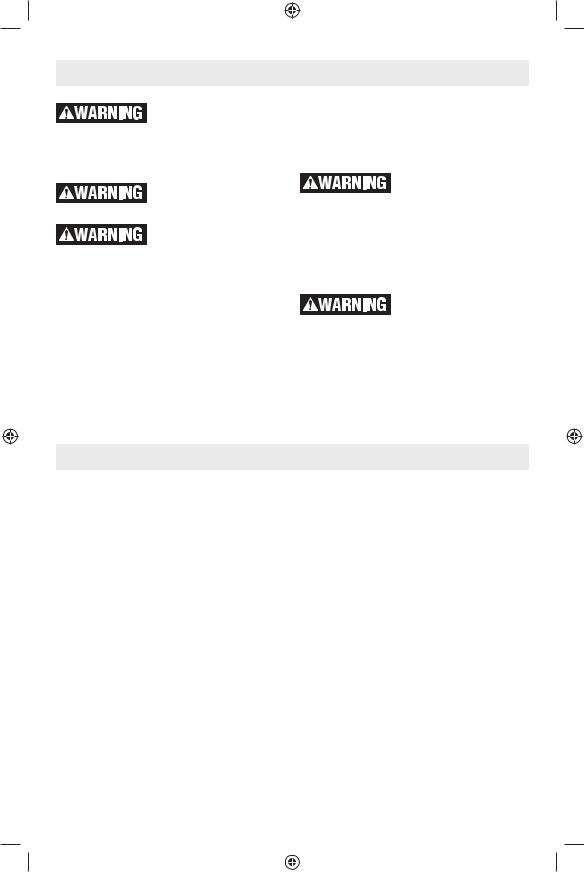
Safety Rules for Pressure Washers
This appliance has been designed for use with cleaning agents for high pressure washers.
Use of other types of cleaning agents or chemicals may adversely affect the safety of the appliance.
Do not use the appliance within range of persons
unless they wear protective clothing.
Risk of injection or injury to persons. High pressure jets can be dangerous if subject to misuse.
The jet must not be directed at persons, animals, live electrical equipment or the appliance itself.
–Do not direct the jet against yourself or others in order to clean clothes or foot-wear.
–Disconnect from the electrical power supply before carrying out user maintenance.
–High pressure cleaners shall not be used by children or untrained personnel.
–To ensure appliance safety, use only original spare parts from the manufacturer or approved by the manufacturer.
High pressure hoses, fittings and couplings are important for the safety of the appliance. Use
only hoses, fittings and couplings recommended by the manufacturer.
– Do not use the appliance if a supply cord or important parts of the appliance are damaged, e.g. safety devices, high pressure hoses, trigger handle.
To reduce the risk of electrocution, keep all connections dry and off the ground. Do not touch plug
with wet hands.
IMPORTANT SAFETy INSTRUCTIONS
SAVE THESE INSTRUCTIONS
Table of Contents
General Safety Rules................................ |
2 |
Safety Rules for Pressure Washers .......... |
5 |
Symbols and Glossary of Terms............... |
6 |
Getting to Know Your Pressure Washer .... |
7 |
Unpacking and Checking Contents .......... |
8 |
Assembly .................................................. |
9 |
Pressure Washer Operation...................... |
11 |
Maintenance and Storage......................... |
14 |
Troubleshooting ........................................ |
16 |
Warranty ................................................... |
18 |
5
F016L81610 1900.indd 5 |
|
|
5/3/17 9:06 AM |
|
|
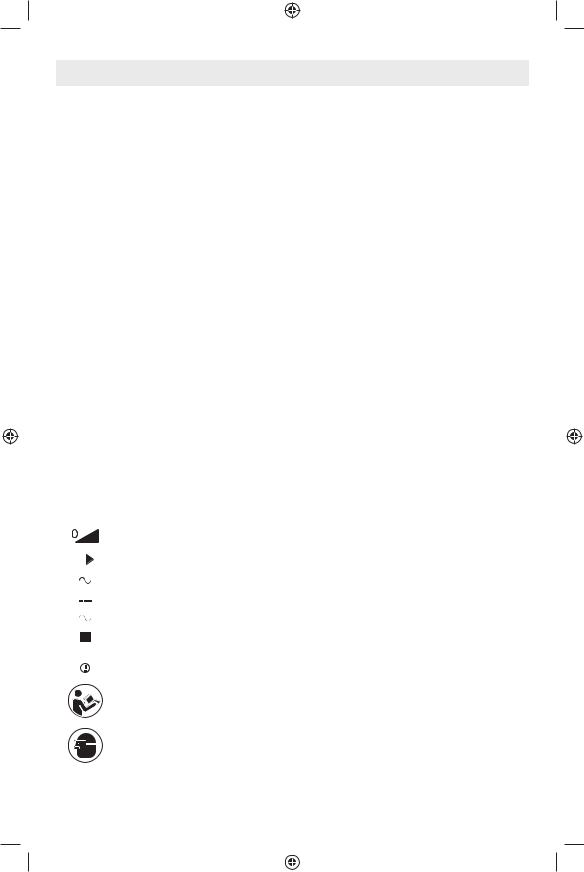
Symbols and Glossary of Terms
IMPORTANT: Some of the following symbols may be used on your pressure washer. Please study them and learn their meaning. Proper interpretation of these symbols will allow you to operate the pressure washer better and safer.
Symbol |
Name |
Designation/Explanation |
||||||
|
|
|
|
|
|
|
|
|
|
|
V |
Volts |
Voltage (potential) |
||||
|
|
|
|
|
|
|
|
|
|
|
A |
Amperes |
Current |
||||
|
|
|
|
|
|
|
|
|
|
Hz |
Hertz |
Frequency (cycles per second) |
|||||
|
|
|
|
|
|
|
|
|
|
|
W |
Watt |
Power |
||||
|
|
|
|
|
|
|
|
|
|
|
kg |
Kilograms |
Weight |
||||
|
|
|
|
|
|
|
|
|
min |
Minutes |
Time |
||||||
|
|
|
|
|
|
|
|
|
|
|
|
s |
Seconds |
Time |
|||
|
|
|
|
|
|
|
|
|
|
|
°F |
Degrees Fahrenheit |
Temperature |
||||
|
|
|
|
|
|
|
|
|
|
°C |
Degrees Celsius |
Temperature |
|||||
|
|
|
|
|
|
|
|
|
PSI |
Pounds per Square Inch |
Pressure |
||||||
|
|
|
|
|
|
|
|
|
GPM |
Gallons per Minute |
Flow |
||||||
|
|
|
|
|
|
|
|
|
|
db |
Decibel |
Noise level |
|||||
|
|
|
|
|
|
|
|
|
|
|
Diameter |
Size of drill bits, grinding wheels, etc. |
|||||
|
|
n0 |
No load speed |
Rotational speed, at no load |
||||
|
|
|
n |
Rated speed |
Maximum attainable speed |
|||
|
|
|
|
|
|
|
|
|
.../min |
Revolutions or reciprocation per min- |
Revolutions, strokes, surface speed, or- |
||||||
|
|
|
|
|
|
|
ute |
bits etc. per minute |
|
|
|
|
|
|
|
|
|
0 |
|
|
OFF position |
Zero speed, zero torque... |
||||
|
|
|
|
|
|
|
|
|
1, 2, 3, ... |
Selector settings |
Speed, torque or position settings. Higher |
||||||
I, II, III, |
|
number means greater speed |
||||||
|
|
|||||||
|
|
|
|
|
|
|
|
|
|
|
|
|
|
|
|
Infinitely variable selector with off |
Speed is increasing from 0 setting |
|
|
|
|
|
|
|
|
|
|
|
|
|
|
|
|
Arrow |
Action in the direction of arrow |
|
|
|
|
|
|
|
||
|
|
|
|
|
|
|
|
|
|
|
|
|
|
|
|
Alternating current |
Type or a characteristic of current |
|
|
|
|
|
|
|
|
|
|
|
|
|
|
|
|
Direct current |
Type or a characteristic of current |
|
|
|
|
|
|
|
||
|
|
|
|
|
|
|
|
|
|
|
|
|
|
|
|
Alternating or direct current |
Type or a characteristic of current |
|
|
|
|
|
|
|
||
|
|
|
|
|
|
|
|
|
|
|
|
|
|
|
|
Class II construction |
Designates Double Insulated Construc- |
|
|
|
|
|
|
|
|
tion tools. |
|
|
|
|
|
|
|
|
|
|
|
|
|
|
|
|
Earthing terminal |
Grounding terminal |
|
|
|
|
|
|
|
||
|
|
|
|
|
|
|
|
|
|
|
|
|
|
|
|
Read manual symbol |
Alerts user to read manual |
|
|
|
|
|
|
|
|
|
|
|
|
|
|
|
|
Wear eye protection symbol |
Alerts user to wear eye protection |
|
|
|
|
|
|
|
|
|
6
F016L81610 1900.indd 6 |
|
|
5/3/17 9:06 AM |
|
|
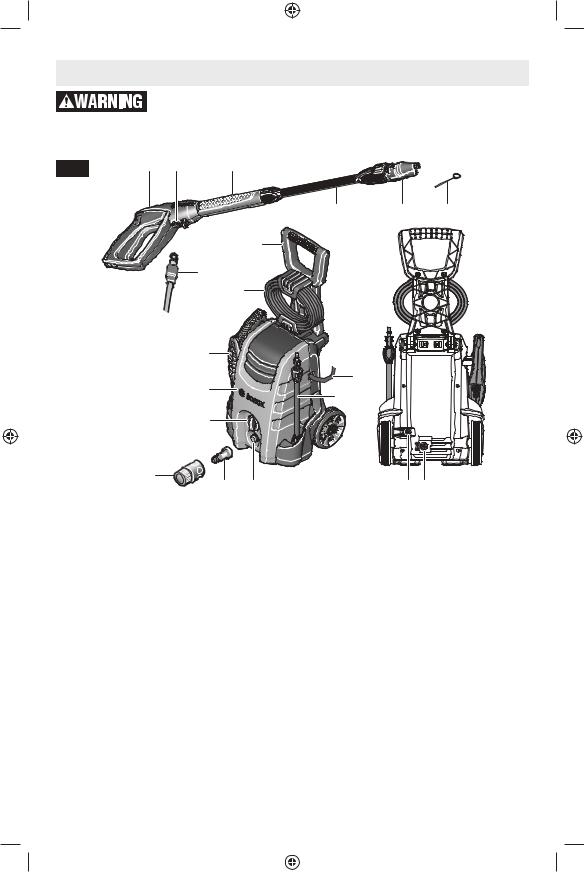
Getting to Know your Pressure Washer
Disconnect the plug from the power source before making any assembly, adjustments or changing accessories. Such preventive safety mea-
sures reduce the risk of starting the pressure washer accidentally.
Pressure Washer
Fig. 1 |
6 |
7 |
8 |
|
|
|
|
|
9 |
10 |
11 |
5
4
4
NOTE: For |
6 |
|
|
|
|
16 |
|
specifications |
1 |
|
|
refer to the |
|
9 |
|
nameplate on |
|
|
|
|
|
|
|
your pressure |
2 |
|
|
washer. |
|
|
|
|
|
|
|
13 |
12 |
3 |
14 15 |
|
1.Pressure Washer Unit – Electric powered pressure washer, it contains the pump and motor.
2.ON OFF Switch – Switch for turning pressure washer on and off.
3.Water Supply Inlet – Connection for water supply hose.
4.Pressure Hose – Hose that carries pressurized water from the unit to the trigger handle.
5.Washer Handle – Folds back against the back of the pressure washer unit for compact storage.
6.Trigger Handle – Control handle that includes the trigger, which actuates the pressure stream.
7.Pressure Hose Inlet – Connection for pressure hose on trigger handle.
8.Barrel – Part of the trigger handle, which the lance connects to. Rotates to adjust angle of fan jet.
9.Lance – Extends the length of the trigger handle and accepts various nozzles.
10.3-in-1 Nozzle – Creates three different water jets. The nozzle setting changes the flow rate, which affects the output pressure.
11.Cleaning Pin – A service tool used to assist in cleaning the nozzle.
12.Water Filter – Removes particles from the incoming water supply.
13.Hose Adapter – Allows connection of the water supply hose to water filter.
14.Detergent Supply Tube – 30cm/1ft long tube for use with detergent container.
15.Pressure Hose Outlet – Connection for pressure hose.
16.Power Cord – Equipped with a GFCI (ground fault circuit interrupter) unit.
7
F016L81610 1900.indd 7 |
|
|
5/3/17 9:06 AM |
|
|
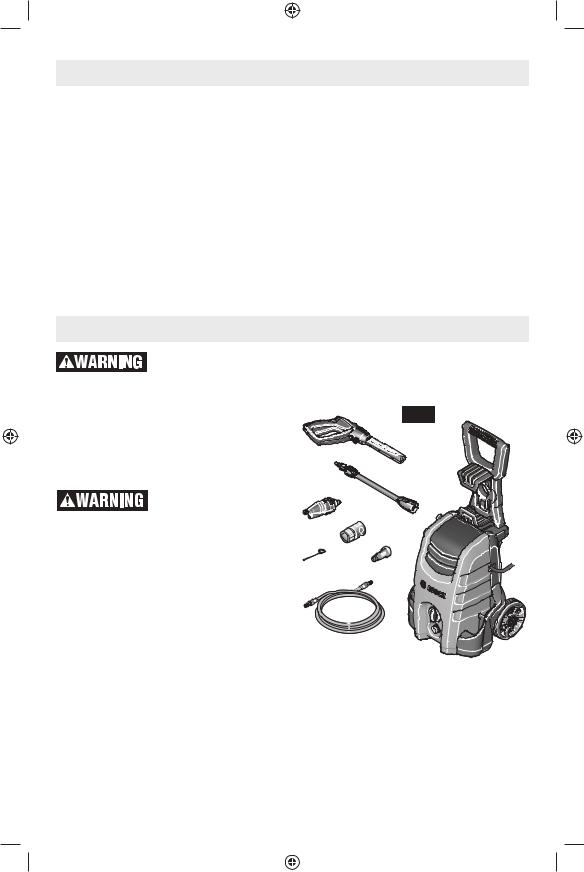
Specifications
Model number |
UniversalAquatak 1900 |
|
|
Rated Voltage |
120 V~ |
|
|
Rated Current |
14 A |
|
|
Maximum water supply temperature |
104 °F (40 °C) |
|
|
Minimum supply rate |
1.72 GPM |
|
|
Allowable pressure |
1885 PSI |
|
|
Rated pressure |
1435 PSI |
|
|
Rated Flow |
1.45 GPM |
|
|
Maximum inlet pressure |
145 PSI |
|
|
Unpacking And Checking Contents
To avoid injury from unexpected starting or electrical shock during unpacking and setting up, do not plug the power cord into a source of
power. This cord must remain unplugged whenever you are working on the pressure washer.
Model UniversalAquatak 1900 Pressure Washer is shipped complete in one carton.
Separate all parts from packing materials and check each one with the illustration (Fig. 2) and the list of loose parts to make certain all items are accounted for before discarding any packing material.
If any parts are missing, do not attempt to assemble the pressure washer, plug in the power
cord or turn the switch on until the missing parts are obtained and are installed correctly.
TABLE OF LOOSE PARTS (Fig. 2)
ITEM |
DESCRIPTION |
QTY. |
|
|
|
A |
Pressure Washer Unit |
1 |
|
|
|
B |
Pressure Hose |
1 |
|
|
|
C |
Trigger Handle |
1 |
|
|
|
D |
Lance |
1 |
|
|
|
E |
Water Filter |
1 |
|
|
|
F |
3-in-1 Nozzle |
1 |
|
|
|
G |
Cleaning Pin |
1 |
|
|
|
H |
Hose Adapter |
1 |
|
|
|
|
|
Fig. 2 |
|
|
C |
|
G |
D |
|
A |
|
|
|
|
|
|
F |
H |
|
E |
|
|
|
|
|
B |
8
F016L81610 1900.indd 8 |
|
|
5/3/17 9:06 AM |
|
|
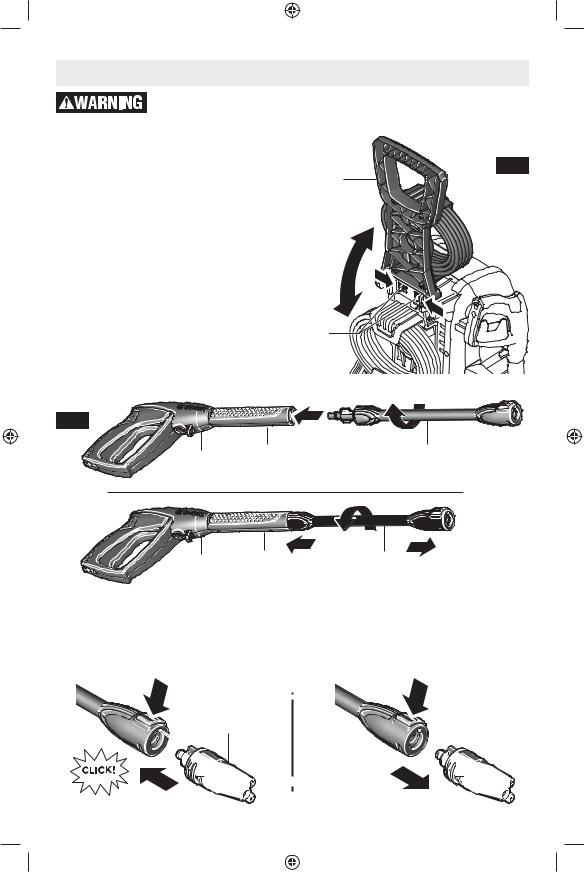
Assembly
Disconnect the plug from the power source before making any assembly, adjustments, or changing accessories. Such preventive safety mea-
sures reduce the risk of starting the pressure washer accidentally.
Using Washer Handle
The handle 5 folds back against the back of |
Fig. 3 |
the pressure washer unit for compact storage. |
|
To unfold the handle, simply move it out and |
5 |
upwards until it securely clicks into the upright |
|
position. To lower the handle squeeze the two |
|
red tabs 5a inwards to release the lock and |
|
push the handle backwards and down (Fig. 3). |
|
Trigger Handle and
Lance Assembly
Attach the lance 9 to the trigger handle 6 by aligning slots, sliding the bayonet connection into the trigger handle barrel 8, and turning
90° clockwise to lock into place (Fig. 4). |
|
|
To disconnect the lance from the trigger han- |
5a |
|
dle, push the lance into the trigger handle bar- |
|
|
rel and then turn the lance 90° counter clock- |
|
|
wise to unlock and pull out the lance (Fig. 4). |
|
|
Fig. 4 |
|
|
6 |
8 |
9 |
|
|
|
6 |
8 |
9 |
|
|
Attaching Nozzle
Attach the 3-in-1 nozzle 10 to the lance 9 by aligning the small nib on the nozzle with the matching recess on the end of the lance and then pushing the nozzle until it clicks in place (Fig. 5).
To disconnect the nozzle from the lance, press the release button and pull the nozzle out (Fig. 5).
9 |
|
Fig. 5 |
|
|
|
10 |
|
|
|
|
|
9
F016L81610 1900.indd 9 |
|
|
5/3/17 9:06 AM |
|
|
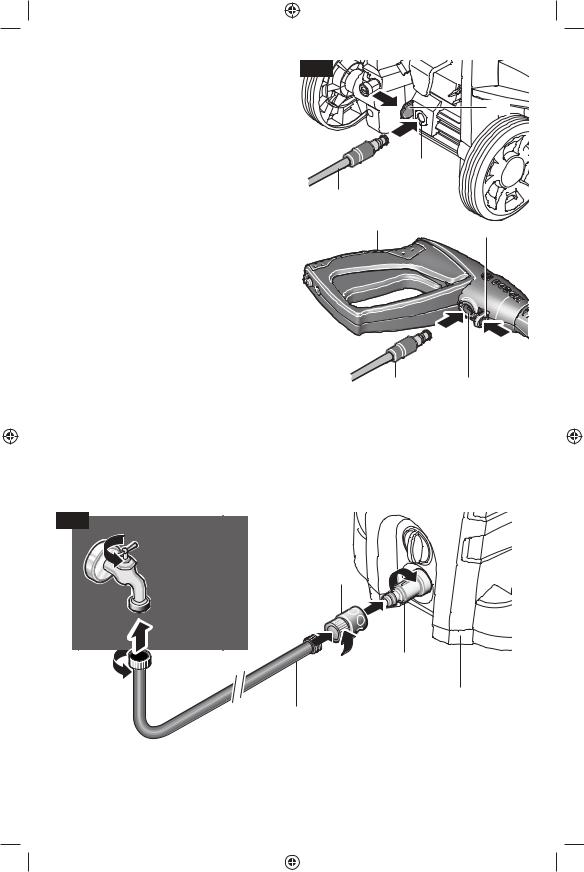
Connecting and Disconnecting |
Fig. 6 |
|
|
Pressure Hose |
|
|
|
Insert one end of the pressure hose 4 (both |
|
|
|
ends are identical) into the pressure outlet 15 |
|
15a |
|
of the pressure washer unit until it clicks. In- |
|
|
|
sert the other end of the pressure hose into |
|
|
|
the pressure inlet 7 of the trigger handle 6 until |
|
|
|
it clicks (Fig. 6). |
|
15 |
|
To release the pressure hose 4 from the wash- |
|
||
|
|
||
er unit, push on the red pressure hose release |
4 |
|
|
lever 15a with one hand and pull out the hose |
|
||
with the other hand.(Fig. 6). |
6 |
|
|
To release the pressure hose 4 from the trig- |
7a |
||
|
|||
ger handle 6, push on the red pressure hose |
|
|
|
release lever 7a with one hand and pull out |
|
|
|
the hose with the other hand (Fig. 6). |
|
|
Connecting and Disconnecting
Water Supply Hose
1.Attach the water filter 12 to the inlet on the front of the pressure washer and finger
tighten clockwise to ensure a watertight seal (Fig. 7).
2. Attach the garden |
hose (not included) to |
|
|
|
the hose adapter 13. Push the hose adapter |
4 |
7 |
||
onto the water filter |
12 until it clicks in place |
|||
|
|
|||
(Fig. 7).
3. Connect the supply hose to the outdoor home water faucet (Fig. 7).
To disconnect the garden hose from the pressure washer, pull on the collar of the hose adapter 13 until it disengages from the water filter 12 (Fig. 7).
Fig. 7
13
12
1
GARDEN HOSE
(NOT INCLUDED)
10
F016L81610 1900.indd 10 |
|
|
5/3/17 9:06 AM |
|
|
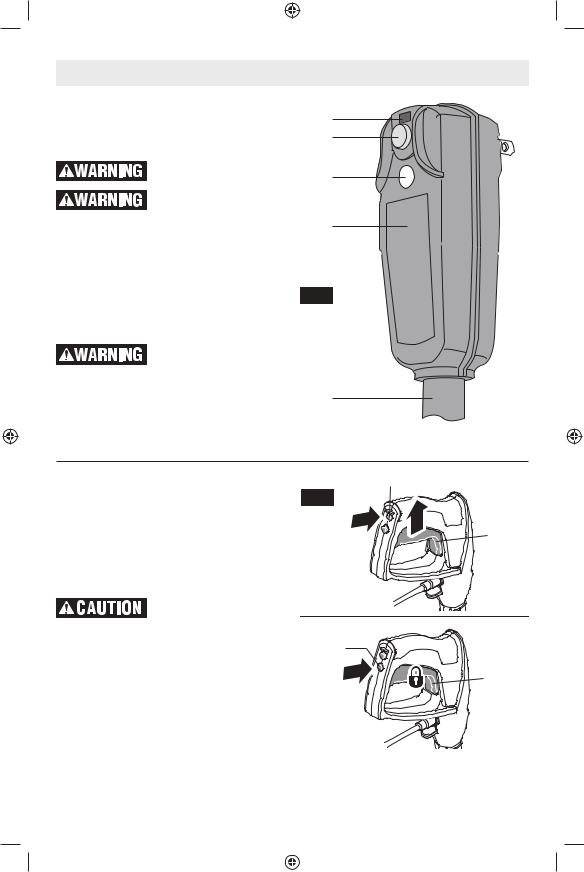
Pressure Washer Operation
GFCI Module
Your pressure washer is equipped with a GFCI (ground fault circuit interrupter) unit mounted on the cord 16.
Do not use extension cord with this product.
Test before each use. A faulty GFCI can result in
electric shock.
1.Plug GFCI unit 16a into power outlet. You should see Red through indicator window 16b (Fig. 8).
2.Press ‘TEST’ button 16d. Red should disappear from the indicator window (Fig. 8).
3.Press and release ‘RESET’ button 16c. Red should reappear in the indicator window (Fig. 8).
If the red fails to appear in the indicator window, then this means the GFCI unit has a problem and
must be replaced. The pressure washer must not be turned on and should be taken to a bosch authorized service center.
16b
16c
16d
16a
Fig. 8
16
Turn on the outdoor home water faucet. Press |
6b |
the trigger release button 6b. Fully press the |
Fig. 9 |
trigger 6a until there is a constant flow of water |
|
to clear the air from the machine and water |
|
supply hose. This may take several seconds |
6a |
depending on the supply hose length. Re- |
|
lease the trigger and press the trigger lock |
|
button 6c (Fig. 9). |
|
Switching On and OFF
To prevent damage to the unit, do not allow it to op-
erate dry.
1. Connect the product to the power outlet en- |
6c |
|
suring that the pressure washer ON/OFF |
||
|
||
switch 2 is in the OFF (O) position (Fig. 10). |
|
2.Turn the switch to the ON (I) position. Point the trigger handle downwards (Fig. 10).
3.Press the trigger release button 6b. Fully press the trigger 6a to start cleaning (Fig. 9).
Autostop function
The pressure washer is designed to switch off the motor when the trigger is released on the trigger handle.
6a
11
F016L81610 1900.indd 11 |
|
|
5/3/17 9:06 AM |
|
|
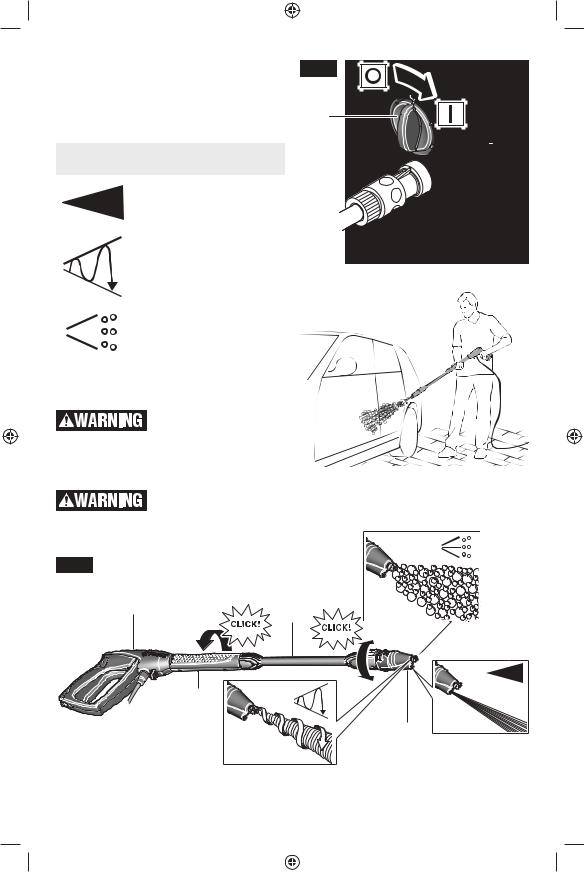
Use of the Cleaning Nozzles
This pressure washer is supplied with a single 3-in-1 nozzle 10. When attached to the lance 9 the nozzle can be rotated to provide three cleaning options (Fig. 11). The options are explained in the table below.
|
Symbol on |
Nozzle Description |
|
|
the Nozzle |
||
|
|
||
|
|
|
|
|
|
|
The fan jet nozzle is for re- |
|
|
|
moving regular dirt and can |
|
|
|
also be used for vehicle |
|
|
|
cleaning. |
|
|
|
|
|
|
|
The Roto nozzle is for clean- |
|
|
|
ing more stubborn dirt on |
|
|
|
pavers and masonry. It |
|
|
|
should not be used on vehi- |
|
|
|
cles or painted surfaces. |
|
|
|
|
|
|
|
The third option is a low pres- |
|
|
|
sure nozzle for rinsing and |
|
|
|
operating the detergent sys- |
|
|
|
tem. |
|
|
|
|
Note: The barrel of the trigger handle can be rotated (in direction shown) to change the angle of the fan jet (Fig. 11).
Do not clean vehicle tires/tire valves from a distance closer than 30 cm. The vehicle tire/
valve could be damaged by the high-pressure jet. The first indication of this is a discoloration of the tire.
Do not use Roto setting to wash vehicles. The high pressure can cause damage to property.
Fig. 11
6 |
9 |
|
8
Fig. 10
2
10
12
F016L81610 1900.indd 12 |
|
|
5/3/17 9:06 AM |
|
|
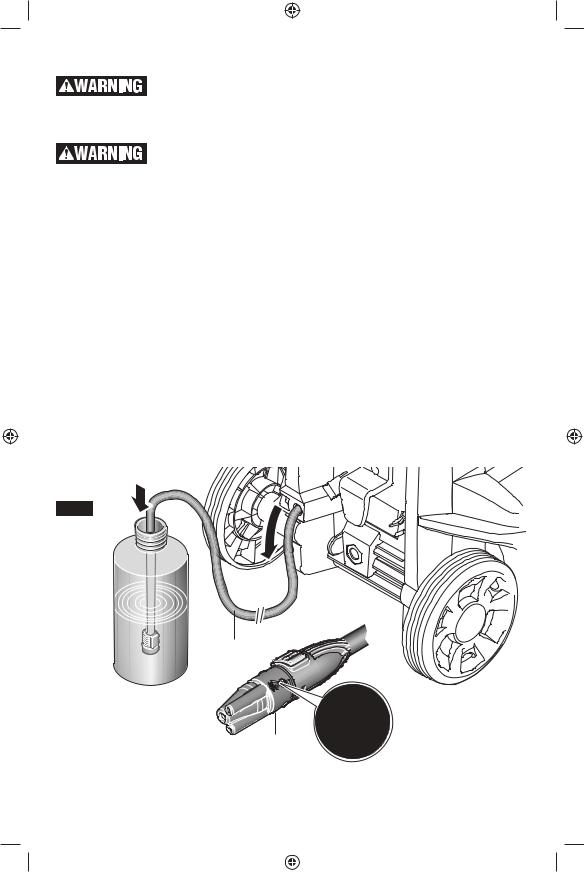
Cleaning with detergents
Only use cleaning agents suitable specifically for high pressure washers. Always comply with
the application, disposal and warning instructions of the detergent manufacturers.
Always use detergent according to the manufacturers warnings and instructions. Im-
proper use can result in personal injury and property damage.
Keep detergents out of the reach of children.
If detergent comes into contact with the eyes, wash immediately with plenty of water and if swallowed contact a doctor immediately.
We recommend that you use detergent sparingly for the sake of the environment. Observe the recommended dilution on the detergent label.
Detergents must not be used undiluted. The products are safe to use if they contain no acids, alkalis or substances which are detrimental to the environment.
Instructions for cleaning with detergents
The detergent supply tube 14 is located on the back of the pressure washer. The tube is approximately 30cm/1ft long. When not in
Fig. 12
use the tube is stowed inside the body of the washer so that just the filter tip is showing. When needed gently pull the filter tip and detergent supply tube out. Place the filter tip into your container of diluted detergent (Fig. 12).
Select the low pressure setting on the 3-in-1 nozzle 10 and begin cleaning.
When finished simply remove the detergent supply tube 14 from the container and wipe off any excess before gently feeding the tube back into the body of the pressure washer.
To flush out the pressure washer simply run with low pressure nozzle selection for one minute using clean water.
Use with Alternative Water Sources
This pressure washer can be used with water tanks that have outlet connections. It’s IMPORTANT that the water is clean and the bOSCH inlet filter is clear and fitted to the machine.
When connecting the pressure washer to a water tank with a suitable tap outlet, first connect the supply hose (not provided) to the tank outlet, open the tap to allow the water to displace all the air in the hose and then connect to the pressure washer.
Pressure hose omitted for clarity
14
10
13
F016L81610 1900.indd 13 |
|
|
5/3/17 9:06 AM |
|
|
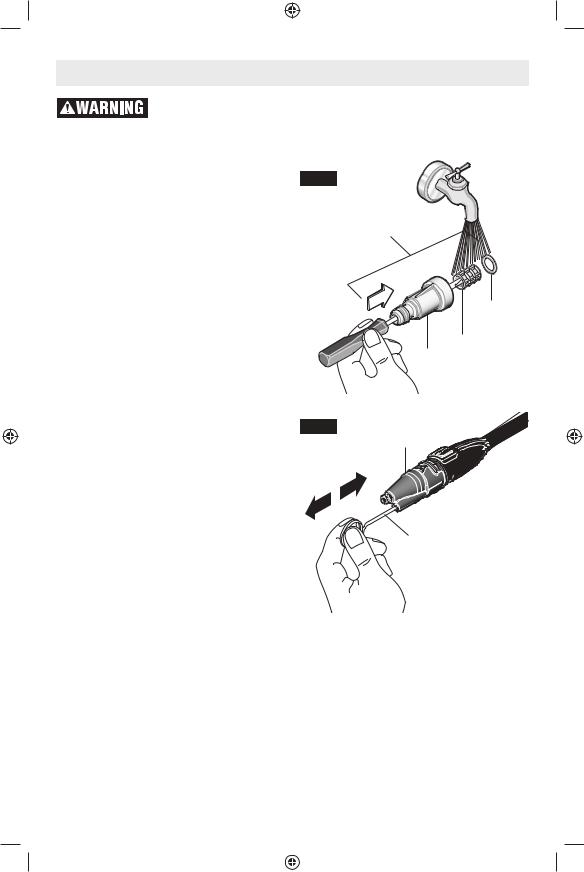
Maintenance and Storage
To avoid possible injury, disconnect plug from power source and disconnect from water supply before performing any assembly, adjustments or repairs. Such preventative safety measures reduce the risk of starting the pressure
washer accidentally.
Maintenance
To ensure long and reliable service, carry out the following maintenance regularly.
Regularly check for obvious defects such as loose fixings, and worn or damaged components.
Check that covers and guards are undamaged and correctly fitted. Carry out necessary maintenance or repairs before using.
Cleaning
Never use the pressure washer without the filter or with a dirty or damaged filter. Using the pressure washer without a filter or with a dirty or damaged filter may invalidate the warranty.
The clear outer casing 12a on the bosch water filter 12 allows the user to see any build-up of sediment. To clean the filter, first unscrew it from the machine and push a small screw driver through the opening to remove the rubber washer 12c and filter barrel 12b. Take care not to lose them. Wash the pieces under a tap to remove any sediment. Reassemble by repositioning the filter barrel 12b within the clear plastic casing 12a and push the rubber washer 12c back into place ensuring that it sits firmly between the filter barrel and screw thread (Fig. 13).
Take care of your pressure washer when in use, be sure to keep connections and accessories clean. A metal cleaning pin 11 is included with the kit enabling the user to remove any material that may become lodged (Fig. 14).
After Use / Storage
Turn the main switch to OFF and operate the trigger to drain the water from the high pressure hose.
Clean the exterior of the machine thoroughly using a soft brush or cloth. Do not use water, solvents or polishes.
Remove all debris, especially from the ventilation slots.
Fig. 13
12
12c
12b
12a
Fig. 14
10
11
Winter Maintenance/Storage
Drain water out of pump by the running motor for a few seconds with the supply hose removed.
Pull the trigger to release all water.
Ensure cables are not trapped when storing. Do not kink high pressure hose.
Store indoors in frost-free area.
Do not place other objects on top of the machine.
14
F016L81610 1900.indd 14 |
|
|
5/3/17 9:06 AM |
|
|
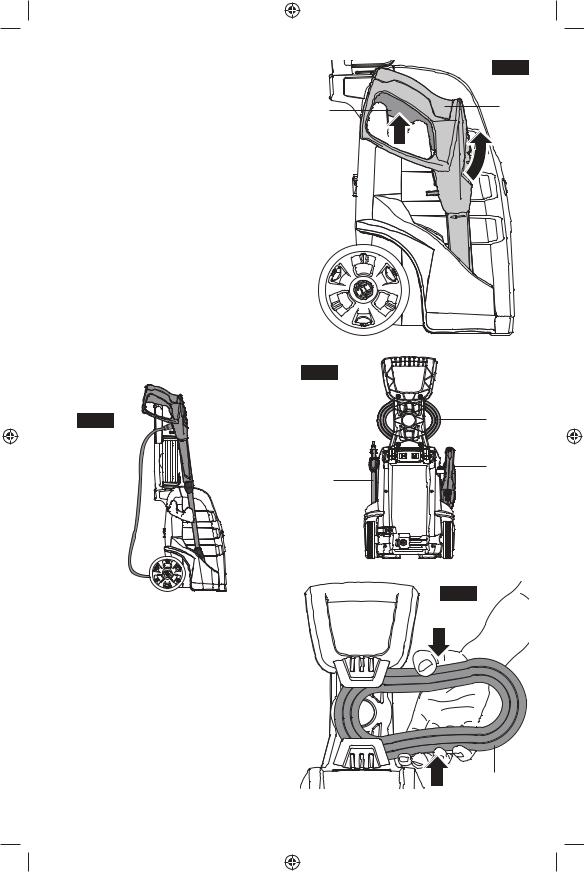
Accessory Storage
The compact design of your bosch pressure washer includes storage for the accessories, convenient for use, mobility and storage.
To store the trigger handle 6 simply place the barrel into the well in the fender, squeeze the trigger 6a and slide the trigger handle over the mounting provided as shown. Release the trigger and the trigger handle will get locked in place. To remove the trigger handle simply reverse the process (Fig. 15).
If the cleaning task is interrupted your bosch pressure washer has safe and practical storage for the ‘in use’ trigger handle (Fig. 17). This also provides and additional time saving storage option if desired.
The pressure hose 4 can be stored on the handle and kept in place by the hose retaining arms provided. Simply coil the hose to about a 40cm/16” length, squeeze it and slide it into place from either side. Once in place release the hose ensuring that there are no kinks (Fig. 18).
Fig. 17
F016L81610 1900.indd 15
6a
Fig. 16
9
Fig. 15
6
4
6
Fig. 18
4
15
5/3/17 9:06 AM
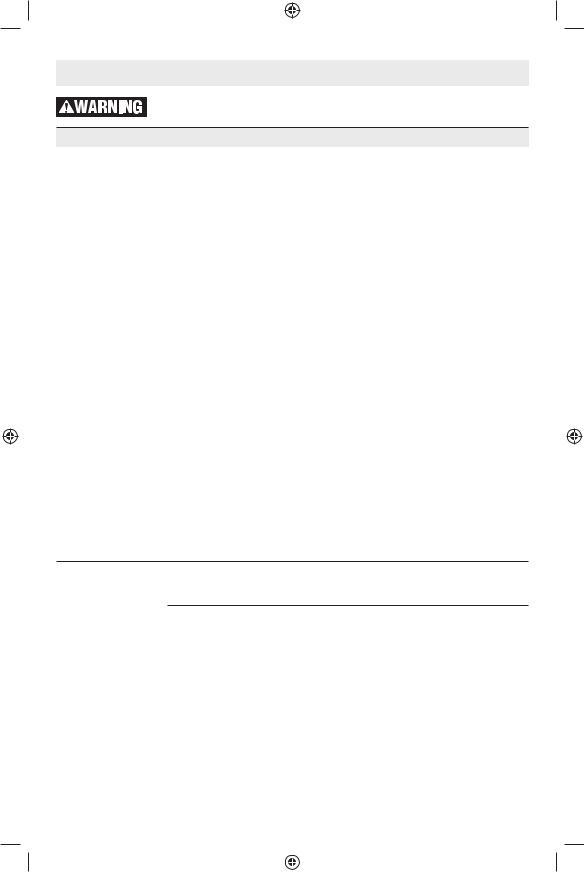
Troubleshooting
Read instruction manual first! Disconnect the plug from the power source before making any assembly, adjustments or changing accessories.
Problem |
Possible Cause |
Corrective Action |
|
|
|
|
|
Motor refuses to |
Plug not connected |
Connect plug |
|
start |
|
|
|
Power outlet faulty |
Use another power outlet |
||
|
|||
|
|
|
|
|
Fuse faulty/blown |
Replace fuse |
|
|
|
|
|
|
Motor protector has |
Allow to cool for 15 minutes |
|
|
activated |
|
|
|
|
|
|
|
Frozen |
Wait for pump/water supply |
|
|
|
hose/accessory to thaw |
|
|
|
|
|
Motor stops |
Fuse faulty/blown |
Replace fuse |
|
|
|
|
|
|
Wrong supply voltage |
Check that supply voltage corresponds |
|
|
|
to specifications on the nameplate |
|
|
|
|
|
|
Motor protector has |
Allow to cool for 15 minutes |
|
|
activated |
|
|
|
|
|
|
|
GFCI is tripped. |
Turn the ON/OFF switch to O (OFF) |
|
|
|
position to turn the washer off; Press |
|
|
|
‘RESET’ button on the GFCI unit. |
|
|
|
|
|
Fuses blow |
Fuses incorrectly rated |
Change to a power outlet higher than |
|
|
|
the pressure washer amp consumption |
|
|
|
|
|
Motor starts but no |
Nozzle partly blocked |
Clean nozzle |
|
pressure |
|
|
|
|
|
|
|
Motor “sounds” but |
Insufficient power supply |
Check that the voltage of the power |
|
fails to start |
|
outlet is the same as that on the |
|
|
|
nameplate |
|
|
|
|
|
|
Appliance not used for a |
Contact your bosch Service Center |
|
|
long period of time |
|
|
|
|
|
|
|
Problems with TSS (Total |
Contact your bosch Service Center |
|
|
Stop System) device |
|
Pressure pulsating Air in the inlet water supply hose/pump
Allow pressure washer to run with open spray handle and nozzle at low pressure until regular working pressure is obtained
|
Inadequate water supply |
Check that the water supply corresponds |
|
|
to specifications. The minimum |
|
|
specification for the water supply hose |
|
|
is 1/2” or 13 mm diameter |
|
|
|
|
Water filter blocked |
Clean water filter |
|
|
|
|
Water supply hoses |
Straighten out kinked water supply hoses |
|
squeezed |
|
|
|
|
|
High pressure hose |
Remove high pressure extension hose. |
|
too long |
Retry (extension hose max. 7m) |
|
|
|
16
F016L81610 1900.indd 16 |
|
|
5/3/17 9:06 AM |
|
|
